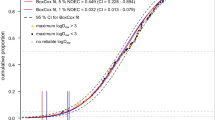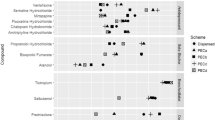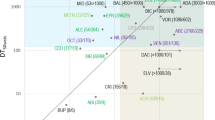Abstract
Environmental risk assessment (ERA) evaluates the likelihood that adverse ecological effects result from exposure to a substance. It therefore requires a consideration of both exposure and effects in relevant environmental compartments. The exposure assessment considers the fate of a substance released to the environment and predicts the environmental concentration or PEC (“predicted environmental concentration”). The effects assessment considers data relating to the effects of the substance upon representative biota and uses such data to predict the no-effect concentration or PNEC (“predicted no-effect concentration”) for the various environmental compartments (i.e. surface waters, sediment, soil, etc.). The PEC and PNEC are combined in order to characterise the risk, i.e. calculation of the PEC/PNEC ratio (see Fig. 25.1). Decisions regarding the safety of the substance depend upon the value of this quotient.
Access this chapter
Tax calculation will be finalised at checkout
Purchases are for personal use only
Preview
Unable to display preview. Download preview PDF.
Similar content being viewed by others
References
Aherne GW, Briggs R (1989) The relevance of the presence of certain synthetic steroids in the aquatic environment. J Pharm Pharmacol 41: 735–736
Aherne GW, English J, Marks V (1985) The role of immunoassay in the analysis of micro-contaminants in water samples. Ecotoxicol Environ Safety 9: 79–83
Boethling RS, Howard PH, Meylan W, Stitler W, Beuman, J, Tirado N (1994) Group contribution method for predicting probability and rate of aerobic biodegradation. Environ Sci Technol 28: 459–465
Bowman WC, Rand MJ (1980) Textbook of pharmacology, end edn. Blackwell Scientific Publications, Oxford
Buser H-R, Poiger T, Müller D (1998) Occurrence and fate of the pharmaceutical drug diclofenac in surface waters: rapid photodegradation in a lake. Environ Sci Technol 32: 3449–3456
CEC (1996) Technical guidance document in support of the Commission Directive 93/67/EEC on risk assessment for new notified substances and Commission Regulation (EEC) No. 1488/94 on risk assessment for existing substances. Commission of the European Communities, European Chemicals Bureau, Ispra, Italy
Cowan CE, Versteeg DJ, Larson RJ, Kloepper-Sams PJ (1995) Integrated approach for environmental assessment of new and existing substances. Reg Toxicol Pharmacol 21: 3–31
Desbrow C, Routledge E, Sheahan D, Waldock M, Sumpter JP (1996) The identification of oestrogenic substances in sewage treatment effluents. Environment Agency, Bristol, UK
Dollery CT (ed) (1991) Therapeutic drugs, vol I and II. Churchill Livingstone, Edinburgh
ECETOC (1995) The role of bioaccumulation in environmental risk assessment: the aquatic environment and related food webs. European Centre for Ecotoxicology and Toxicity of Chemicals, Brussels (Technical Report 67 )
Eckerman I, Martineus JC (1997) Medicines and the environment: what do we know today? Swedish Association of Physicians for the Environment ( SLFM ), Stockholm
FDA (1995) Streamlining food and drug administration - environmental assessments. FDA Backgrounder BG95–9 (March 16, 1995 )
FDA (1996) z1 CFR Part 25 - National Environmental Policy Act: proposed revision of policies and procedures; proposed rule. Federal Register 61(65):14922–14942
FDA-CDER (1996) Retrospective review of ecotoxicity data submitted in environmental assessments. FDA Center for Drug Evaluation and Research, Rockville ( MD ), USA (Docket No. 96N - 0057 )
FDA-CDER (1998) Guidance for industry - environmental assessment of human drugs and biologics applications. FDA Center for Drug Evaluation and Research, Rockville MD, USA (CMC6 Revision 1, http://www.fda.gov/cder/guidance/index.htm)
FWR (1995) Effects of trace organics on fish - Phase 2. Foundation for Water Research, Marlow ( Bucks. ), UK (FR/D 0022 )
Halling-Sorensen B, Nielsen SN, Lanzky PF, Ingerslev F, Holten Lützhoft HC, Jorgensen SE (1998) Occurrence, fate and effects of pharmaceutical substances in the environment–a review. Chemosphere 36 (2): 357–393
Hansch C, Leo A, Hoekman D (1995) Exploring QSAR - hydrophobic, electronic and steric constants. American Chemical Society, Washington DC, USA (ACS Professional Reference Book )
Heide EF Van Der, Hueck Van Der Plas EH (1984) Genessmiddelen en milieu. Pharmaceutisch Weekblad 119936–947
Henschel KP, Wenzel A, Diederich M, Fliedner A (1997) Environmental hazard assessment of pharmaceuticals. Reg Toxicol Pharmacol 25: 220–225
Hirsch R, Ternes T, Haberer K, Kratz KL (1999) Occurrence of antibiotics in the aquatic environment. Sci Total Environ 225: 109–118
Hoekman D (1997) http://clogp.edu/medchem/chem/clogp/drugs/html (Internet site)
Holten Lützhoft HC, Halling-Sorensen B, Jorgensen SE (1998) Algal testing of antibiotics applied in Danish fish farming. SETAC-Europe 8th Annual Meeting 14–18th April 1998, Bordeaux (Abstract 4I/004)
Hussain Z, Hennessy T (1995) EC environmental risk assessment (1). The Regulatory Affairs Journal 6 (8): 634–640
Kalbfus W (1995) Belastung bayerischer Gewässer durch synthetische Östrogene. Vortag bei der 50. Fachtagung des Bayerischen Landesamtes für Wasserwirtschaft “Stoffe mit endokriner Wirkung im Wasser” (Abstract). (Effects in Bavarian watercourses through synthetic oestrogens. Presentation at the 5oth Seminar of the Bavarian Association for Waters Supply “Substances with endocrine effects in water”)
Köpf W (1995) Wirkung endokriner Stoffe in Biotests mit Wasserorganismen. Vortag bei der 50. Fachtagung des Bayerisches Landesamt für Wasserwirtschaft “Stoffe mit endokriner Wirkung im Wasser” (Abstract). (Effects of endocrine substances in bioassays with aquatic organisms. Presentation at the 5oth Seminar of the Bavarian Association for Waters Supply “Substances with endocrine effects in water”)
Kühn R, Pattard M, Pernak KD, Winter A (1989) Results of the harmful effects of selected water pollutants (anilines, phenols, aliphatic compounds) to Daphnia magna. Wat Res 23(4)495–499
Kämmerer K, Al-Ahmad A, Betram B, Wießler M (2000) Biodegradability of antineoplastic compounds in screening tests: influence of glucosidation and of stereochemistry. Chemosphere 40: 767–773
Länge R, Schweinfurth H, Croudace C, Panther G (1997) Growth and reproduction of fathead minnow (Pimephales promelas) exposed to the synthetic steroid hormone ethinylestradiol in a life cycle test (Abstract). 7th Annual Meeting of SETAC-Europe April 6–10,1997, Amsterdam, the Netherlands.
Mackay D (1982) Correlation of bioconcentration factors. Environ Sci Technol 16: 274–276
Newton DW, Kluza RB (1978) pKa values of medicinal compounds in pharmacy practice. Drug Intell Clin Pharm 12: 546–554
Olejniczak K (1995) Environmental risk assessment for medicinal products in the EU, Phase I. In: Wolf PU (ed) Environmental risk assessment for pharmaceuticals and veterinary medicines. RCC Group, Itingen, CH ( Proceedings of the International ACC Workshop held in Basel, Switzerland, February 1, 1995, pp 58–66 )
Panter GH, Thompson RS, Beresford N, Sumpter JP (1999) Transformation of a non-oestrogenic steroid metabolite to an oestrogenically active substance by minimal bacterial activity. Chemosphere 38(15)3579–3596
Peterson SM, Batley GE, Scammell MS (1993) Tetracycline in antifouling paints. Mar Pollut Bull 26 (2): 96–100
Purdom CE, Hardiman PA, Bye VJ, Eno NC, Tyler CR, Sumpter JP (1994) Estrogenic effects of effluents from sewage treatment works. Chem Ecol 8: 275–285
Raymond GG, Born JL (1986) An updated pKa listing of medicinal compounds. Drug Intell Clin Pharm 20: 683–686
Reynolds JEF (ed) (1996) Martindale - the extra pharmacopoeia (electronic version). The Royal Pharmaceutical Society of Great Britain. Micromedex Inc., Engelwood, CO, USA
Richardson ML, Bowron JM (1985) The fate of pharmaceutical chemicals in the aquatic environment. J Pharm Pharmacol 37: 1–12
Schweinfurth H, Länge R, Günzel P (1996) Environmental fate and ecological effects of steroidal estrogens. Presentation at the Oestrogenic Chemicals in the Environment conference organised by IBC Technical Services Ltd in London on the 9th and loth May, 1996
Ternes TA (1998) Occurrence of drugs in German sewage treatment plants and rivers. Chemosphere 32(11)3245–3260
Ternes TA, Stumpf M, Mueller J, Haberer K, Wilken R-D, Servos M (1999) Behaviour and occurrence of estrogens in municipal sewage treatment plants–I. Investigations in Germany, Canada and Brazil. Sci Total Environ 225: 81–90
Veith GD, Kosian P (1983) Estimating bioconcentration potential from octanol/water partition coefficients. In: Mackay D, Paterson R, Eisenreich S, Simmons M (eds) PCBs in the Great Lakes. Ann Arbor Science, Ann Arbor, MI, USA (Chap 15 )
Watts CD, Crathorne B, Fielding M, Steel CP (1983) Identification of non-volatile organics in water using field desorption mass spectrometry and high performance liquid chromatography. In: Angeletti G, Bjorseth A (eds) Analysis of organic micropollutants in water. D. D. Reidel Publishing Company, Dordrecht, pp 120–131
Webb SF (1995) Current status of the European guidelines on environmental risk assessment. ESRA Rapporteur 2 (3): 27
Webb SF (1998) A data-based perspective on the environmental risk assessment (ERA) of human pharmaceuticals (Abstract). SETAC-Europe 8th Annual Meeting Interfaces in Environmental Chemistry and Toxicology: from the global to the molecular level (April 14–18,1998), Bordeaux, France WSA (1994) Waterfacts ‘84. Water Services Association, London
Editor information
Editors and Affiliations
Rights and permissions
Copyright information
© 2004 Springer-Verlag Berlin Heidelberg
About this chapter
Cite this chapter
Webb, S.F. (2004). A Data Based Perspective on the Environmental Risk Assessment of Human Pharmaceuticals Il — Aquatic Risk Characterisation. In: Kümmerer, K. (eds) Pharmaceuticals in the Environment. Springer, Berlin, Heidelberg. https://doi.org/10.1007/978-3-662-09259-0_25
Download citation
DOI: https://doi.org/10.1007/978-3-662-09259-0_25
Publisher Name: Springer, Berlin, Heidelberg
Print ISBN: 978-3-662-09261-3
Online ISBN: 978-3-662-09259-0
eBook Packages: Springer Book Archive




